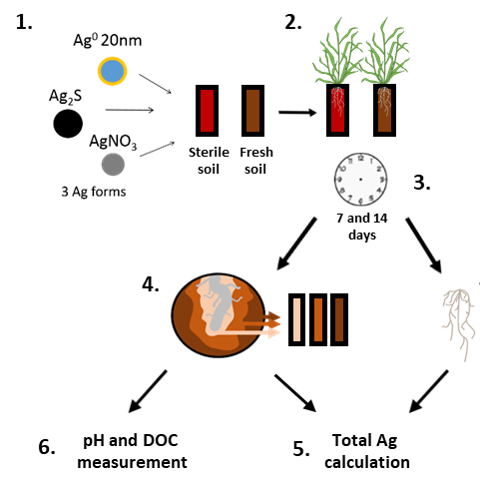NanoFASE Case Study: Rhizosphere Influence on Bioavailability of Ag-NP to Wheat In Soil Exposures
Silver nanoparticles can enter the soil through the application of sewage sludge to agricultural land. The silver in the sewage sludge will most likely be in the transformed, sulphidised form. Plants growing on this agricultural land will therefore be exposed to silver which may accumulate in their tissues. The rhizosphere can modify the soil environment surrounding the roots. NanoFASE investigated whether different soil fractions (bulk soil, loosely attached soil or rhizosphere soil including its microbial community) had differential influence on the availability of Ag to the plants.
Study aim |
|
|
This study investigates the effect of the soil microbial community and the rhizosphere on the bioavailability of three silver forms (Ag0 Engineered Nanomaterials, Ag2S ENM and AgNO3) to wheat, Triticum aestivum.
|
Experimental approach |
Overview |

|
Compartment involved: Rhizosphere soil NP type/size: 20 nm Ag NP PVP coated (AppNano) Species:
Wheat (Triticum aestivum) Bioassay:
Bioaccumulation assay Extractable Ag assay |
Results |
- After 14 days there was increased extractable Ag in the rhizosphere soils compared to the bulk soil.
- There was a positive relationship between accumulation and extractable Ag in the rhizosphere soil compared to the bulk soil for the Ag NP forms
- 20 nm pristine lowered bacterial and fungal diversity compared to other treatments but did not vary over 14 days.
- Rhizosphere soil had lower variation in diversity compared to bulk soil.
Parameters |
|
|
Read more |
Read also |
|
Visit the NanoFASE Library to read summaries of these reports: NanoFASE Report D9.4 Validated parameter set on uptake and toxicokinetics of aged NMs in aquatic and terrestrial organisms and for biomagnification potential (summary of internal report)
|
Gao X, Avellan A, Laughton S, Vaidya R, Rodrigues SM, Casman EA, Lowry GV. (2018) CuO Nanoparticle Dissolution and Toxicity to Wheat (Triticum aestivum) in Rhizosphere Soil. Environ Sci Technol. 2018 Mar 6; 52 (5): 888-897. Stegemeier, J. P., et al. (2015). "Speciation Matters: Bioavailability of Silver and Silver Sulfide Nanoparticles to Alfalfa (Medicago sativa)." Environ Sci Technol. 49(14): 8451-8460. |
Contact
 Amaia Green Etxabe
Amaia Green Etxabe
Centre for Ecology and Hydrology (CEH)
Wallingford, UK
 Elma Lahive
Elma Lahive
Centre for Ecology and Hydrology (CEH),
Wallingford, UK
